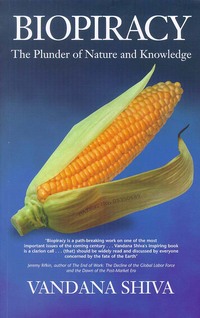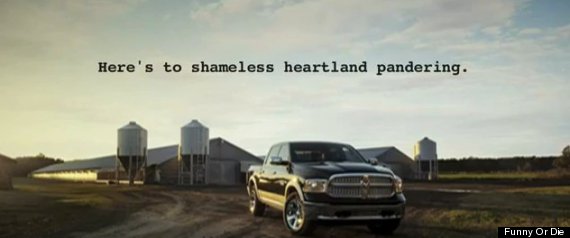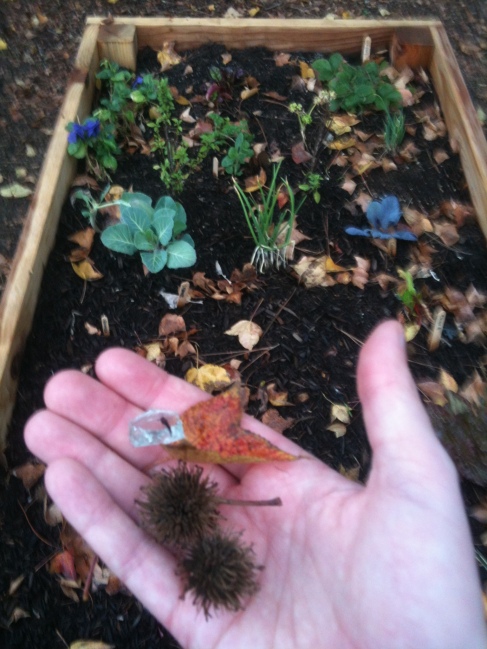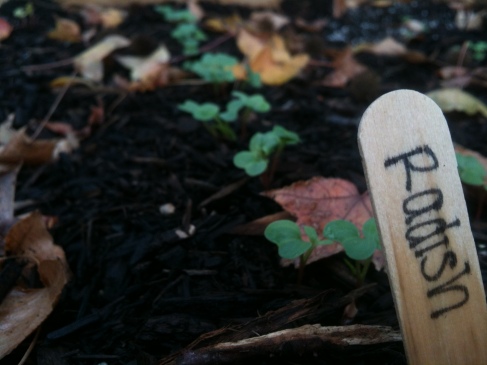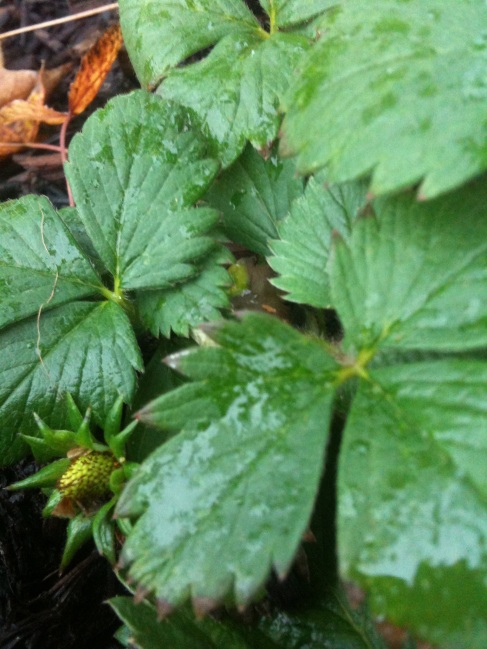Book Review: Biopiracy by Vandana Shiva
Posted: March 18, 2013 Filed under: Book reviews, Factory Farming & Big Ag, local/national/global, Policy, Race Issues | Tags: Biopiracy, Ecofemenism, GATT, Indigenous Knowledge, IPR, Patent Law, Vandana Shiva Leave a commentIn “Biopiracy: The Plunder of Nature and Knowledge” (1997), Vandana Shiva explores the exploitation of the Third World by the North (West). Major corporations have invaded native communities and environments for commercial interests. In referencing the shift from colonialism to more modern forms of oppression, Shiva writes, “the duty to incorporate savages into Christianity has been replaced by the duty to incorporate non-Western systems of knowledge into the reductionism of commercialized Western science and technology”.
Community knowledge of the intricately interwoven ecosystems of forests, crops, and livestock has for generations sustainably maintained local economies. Biopiracy refers to the theft of this knowledge by corporations seeking to patent indigenous crops, animals and methods of farming.
Vandana Shiva argues that in the return to sustainable practices, science and society have much to learn from indigenous practices and native populations. The rate at which resources are used has spiked only in the last two centuries as globalization and the rise of technology and industry increased production and waste. Our current overzealous habits represent a discord between man and nature as ecosystems are disrupted, species lost, and native communities exploited. Instead of man and woman cohabitating with nature, Shiva explains, we have come to view nature as something to be dominated. Because indigenous knowledge is inherently gendered, both nature and women have come to be dominated and exploited by man. In regarding indigenous knowledge and the work of women, western frameworks have systematically undervalued both systems and their contributions to modern networks.
The Indian view of nature and man, in contrast, presents “..a duality in unity”. In modern society, science and technology have become cognitively inseparable, creating a form of social control. Because science is seen as verifiable and objective, consequent uses of science and technology are rarely questioned. In order to remedy gender relations as they relate to science and technology, it is important not to vilify knowledge, which, although previous misused, may be helpful in a more egalitarian framework. Keeping in mind the past injustices suffered by native communities at the hands of European colonists, indigenous knowledge has survived many setbacks. Regardless, indigenous knowledge systems have contributed greatly to modern science, agriculture and medicine.
Biopiracy was a great book. Vandana Shiva is great writer who makes her claims boldly and references many examples. Her main claim, that no person or corporation can claim ownership of nature is repeated throughout her writing. Shiva fights for independence and autonomy from corporations who only seek profits from the countries they have exploited. Governmental institutions have been complicit in these crimes, enforcing restrictions on Third World countries and limiting them from using their own land sustainably.
This book is relevant to all that we have learned this quarter because as we each become urban agriculturists (or support others who do so) we must be mindful of the agroeconomic systems that we are benefiting from. It is important to realize that everything, from the seeds and soil to the techniques we use are all in some form, are the effect of generations-old techniques used by indigenous and Third-World peoples.
Check It Out! Ron’s TED Talk
Posted: March 6, 2013 Filed under: Los Angeles, Media, Race Issues | Tags: Guerilla Gardening, los angeles, Ron Finley, South Central, TED Talk, urban agriculture Leave a commenthttp://www.ted.com/talks/ron_finley_a_guerilla_gardener_in_south_central_la.html
2/22 Garden Check-In
Posted: February 22, 2013 Filed under: E3, Garden tasks, Watering | Tags: Bee, Blaise, compost, lettuce, Seeds, watering Leave a commentI wandered up to the garden this afternoon (after having come back from Garden Mentorship in Santa Monica that morning) looking forward to tending to our plants. Since they had already been watered, I walked around and weeded a bit in between beds and removed debris inside the beds.
After listening to our Seed Library guest lecture on Tuesday, I am excited to gather our lettuce seeds once they become ready.
I noticed something that I found odd in the gardens as well. There were a lot (at least six) bees walking around on our melon/tomato seedling containers. I don’t know what it is about them that attracted the bees…they have no flowers, and barely have risen above the soil line…but alas the bees liked them!
After going around to the beds and checking in on our seedlings and compost, I took a nap in the sun….then got woken up by frisbee throwers and decided to doodle on the compost containers. (I also had to re-attach Blaise’s head because it had been knocked to the floor!)
I encourage others to add some art to the garden! I’d like to make some bird feeders and signs for the garden…maybe we can have a weekend workday for garden beautification!
Green Onions (Scallions) vs. Chives
Posted: February 12, 2013 Filed under: Uncategorized | Tags: Chives, Green Onion, Herbs, Onion, Scallion Leave a commentThey are not the same thing! A few students and I were wondering this today…here is the answer!

(Top) Green Onion/Scallion and (Bottom) Chives
TEDx – Urban Farming Revolution
Posted: February 12, 2013 Filed under: Farming, Films and Video, Los Angeles, Media | Tags: BigAg, los angeles, urban agriculture Leave a comment
Jesse DuBois is an urban agriculturalist. He moved to Los Angeles to become a screenwriter, but instead got caught up in reshaping the food system. He is the CoFounder and currently serves as the Chief Eclectic Officer for two start-ups: Farmscape, an urban farming maintenance company, and Agrisaurus, a web-based polyculture gardening assistant.
A Makeover for Blaise
Posted: February 12, 2013 Filed under: Fruit, Garden tasks, Watering | Tags: Banana, Banana Tree, Blaise, citrus, compost, Kitchen Scraps, Lime, Potato, Scarecrow, Soil Test Kit, Watermelon Leave a commentToday, during class, I decided to give Blaise the scarecrow a makeover. S/he was looking pretty drab (see previous posts), and was missing a head, so I took one of the large mystery fruits from our citrus tree and sharpied on a face! Isn’t s/he stunning??
Blaise adds a touch of whimsy to our garden, and is now standing at the front entrance, ready to greet all new visitors with a smile!
Today we worked on our compost. We added water and stirred (aerated) it, making sure it was the right consistency. I identified a banana tree next to the compost and am intrigued to watch for its progress.
I also brought over two potatoes from home, which I hadn’t used quickly enough! They started to sprout ‘eyes’, so I googled how to plant potatoes. According to a website, you simply cut them into chunks (making sure that each segment has at least one eye, or sprout) let those segments dry out, forming a callous over the skin to prevent rotting, and then plant them 6 in. deep in soil. I think they need one more day to properly dry out, so they are sitting on one of the work stations. Later this week they will be ready to plant!
It would be great to learn about other ways we can use kitchen scraps to grow our garden.
The garden needs a new soil test kit! We need to test out soil pH levels to determine if we need to add any substances for our blueberry bushes. Blueberries like a very alkaline environment (5.0-6.0 pH) in order to thrive. Unfortunately, the kit I found in the shed was old and missing parts.
The limes are doing well, continuing to flower and produce more fruit!
James had planted some watermelon seeds, which have sprouted! I am very excited to plant them and have watermelon in a few months! These Dixie Queen Watermelon will need a lot of room to grow, however, so we must plant wisely and anticipate their growth.
‘God Made A Factory Farmer’ Video Spoof
Posted: February 6, 2013 Filed under: Factory Farming & Big Ag, Farming, Films and Video, Media Leave a commentHey guys! I just came across this video parody of the Dodge Superbowl ad ‘God Made A Farmer’ that we watched in class yesterday. It was produced by FunnyorDie. Have a good laugh :]
(click on the above photo for a link to the video)
Garden Visit: Friday, January 25th
Posted: January 26, 2013 Filed under: Watering | Tags: Chives, Radish, Strawberry, watering Leave a commentOn Friday afternoon I visited the gardens. It had been raining earlier in the day, giving all of the plants fresh water. When I got to the gardens I started out going to each bed and removing unwanted items like seed pods from the trees above, pine cones, large pieces of bark, and even a piece of glass!
I went around to each spot that we had planted seeds in and monitored their progress. So far, the chives haven’t come up yet but a neat line of Radish have sprouted and are looking wonderful!
I also noticed that on one of the Strawberry plants (which was already up at the garden before we created the new beds) has produced its first Strawberry! I will keep an eye on the plant and on any more new strawberries that appear.
What needs to be done: The next visitors to the garden should continue removing unwanted debris from the beds and keep an eye out for the new seedlings.
